ডিএসপিএল স্কিমা
সেভ করা পৃষ্ঠা গুছিয়ে রাখতে 'সংগ্রহ' ব্যবহার করুন
আপনার পছন্দ অনুযায়ী কন্টেন্ট সেভ করুন ও সঠিক বিভাগে রাখুন।
এই পৃষ্ঠা এবং এর লিঙ্কযুক্ত সাবপেজগুলি DSPL XML স্কিমা নথিভুক্ত করে। এই উপাদানটি উন্নত ব্যবহারকারীদের জন্য যারা ভাষার নিম্ন-স্তরের বিবরণ বুঝতে চান; বেশিরভাগ ব্যবহারকারীর জন্য, বিকাশকারী গাইডের বিষয়বস্তু DSPL ডেটাসেট তৈরি এবং সম্পাদনা করার জন্য যথেষ্ট হওয়া উচিত।
সম্পূর্ণ XML স্কিমা DSPL কোড সাইটে XSD ফর্ম্যাটে ডাউনলোডের জন্য উপলব্ধ।
উপাদান: ডিএসপিএল
| নামস্থান | http://schemas.google.com/dspl/2010 |
|---|
| টীকা | একটি DSPL স্পেসিফিকেশন একটি ডেটাসেট বর্ণনা করে। একটি ডেটাসেট তার নামস্থান দ্বারা চিহ্নিত করা হয়। একটি ডেটাসেট নিম্নলিখিত উপাদানগুলির সমন্বয়ে গঠিত: - সারণী: ডেটাসেটে সংজ্ঞায়িত ধারণা এবং স্লাইসগুলির জন্য ডেটা - ধারণাগুলি: ডেটাসেটে ব্যবহৃত ব্যবহারকারী-নির্দিষ্ট সংজ্ঞা এবং কাঠামো - স্লাইস: ডেটাসেটে উপস্থিত মাত্রা এবং মেট্রিক্সের সমন্বয় - বিষয়গুলি: শ্রেণীবদ্ধ লেবেলগুলি ডেটাসেটের ধারণাগুলিকে সংগঠিত করতে ব্যবহৃত হয়৷ |
|---|
| ডায়াগ্রাম | 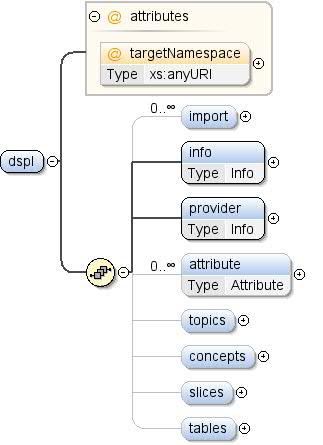 |
|---|
| বৈশিষ্ট্য | |
|---|
| মডেল | আমদানি* , তথ্য , প্রদানকারী , বৈশিষ্ট্য* , বিষয়গুলি{0,1} , ধারণাগুলি{0,1} , স্লাইসগুলি{0,1} , টেবিলগুলি{0,1} |
|---|
| শিশুরা | বৈশিষ্ট্য , ধারণা , আমদানি , তথ্য , প্রদানকারী , স্লাইস , টেবিল , বিষয় |
|---|
| দৃষ্টান্ত | <dspl targetNamespace="">
<import location="" namespace="">{0,unbounded}</import>
<info>{1,1}</info>
<provider>{1,1}</provider>
<attribute concept="" id="">{0,unbounded}</attribute>
<topics>{0,1}</topics>
<concepts>{0,1}</concepts>
<slices>{0,1}</slices>
<tables>{0,1}</tables>
</dspl> |
|---|
| গুণাবলী | | QName | টাইপ | স্থির | ডিফল্ট | ব্যবহার করুন | টীকা |
|---|
| টার্গেট নেমস্পেস | xs:anyURI | | | ঐচ্ছিক | প্রতিটি ডেটাসেট একটি টার্গেট নেমস্পেস প্রদান করতে পারে। টার্গেট নেমস্পেস হল একটি URI যা ডেটাসেটটিকে অনন্যভাবে সনাক্ত করে। XML-এ নেমস্পেসের ব্যবহার সম্পর্কে আরও তথ্যের জন্য, দেখুন: http://www.w3.org/TR/REC-xml-names/ যদি কোন টার্গেটনেমস্পেস প্রদান করা না হয়, তাহলে ডেটাসেট আমদানি করা হলে একটি নামস্থান তৈরি করা হবে। |
|---|
|
|---|
| উৎস | <xs:element name="dspl">
<xs:annotation>
<xs:documentation>A DSPL specification describes a dataset. A dataset is
identified by its namespace. A dataset is comprised of the
following elements:
- Tables: Data for the concepts and slices defined in the
dataset
- Concepts: User-specified definitions and structures used in
the dataset
- Slices: Combinations of dimensions and metrics present in
the dataset
- Topics: Hierarchical labels used to organise the concepts of
the dataset</xs:documentation>
</xs:annotation>
<xs:complexType>
<xs:sequence>
<xs:element name="import" minOccurs="0" maxOccurs="unbounded">
<xs:annotation>
<xs:documentation>Import directive for external datasets -- modeled after
the XML Schema import directive. In order to use
elements defined in an external dataset, the external
dataset must be referenced using an import directive.</xs:documentation>
</xs:annotation>
<xs:complexType>
<xs:attribute name="namespace" use="required">
<xs:annotation>
<xs:documentation>The namespace of the imported dataset, specified as
a URI. A prefix must be associated with this
namespace before its contents can be referenced. See
[XML Namespaces] for more information about the use
of namespaces and prefixes in XML.</xs:documentation>
</xs:annotation>
</xs:attribute>
<xs:attribute name="location" use="optional">
<xs:annotation>
<xs:documentation>An optional location where the definition of the
imported dataset can be found, specified as a
URL. If the location is omitted, the system
processing this DSPL dataset must already know the
imported dataset.
Implementation note: The Google dataset importer
ignores the location attribute. Any imported dataset
must be known by the Google importer beforehand.</xs:documentation>
</xs:annotation>
</xs:attribute>
</xs:complexType>
</xs:element>
<xs:element name="info" type="Info" minOccurs="1">
<xs:annotation>
<xs:documentation>General information about the dataset.</xs:documentation>
</xs:annotation>
</xs:element>
<xs:element name="provider" type="Info">
<xs:annotation>
<xs:documentation>General information about the dataset provider.</xs:documentation>
</xs:annotation>
</xs:element>
<xs:element name="attribute" type="Attribute" minOccurs="0" maxOccurs="unbounded">
<xs:annotation>
<xs:documentation>Attribute associated with the dataset.</xs:documentation>
</xs:annotation>
</xs:element>
<xs:element name="topics" minOccurs="0">
<xs:annotation>
<xs:documentation>A hierarchy of topics used to organize the contents of
the dataset. The order in which topics are given is
meaningful and should be respected by visualizations
that displays these topics.</xs:documentation>
</xs:annotation>
<xs:complexType>
<xs:sequence>
<xs:element name="topic" type="Topic" maxOccurs="unbounded"/>
</xs:sequence>
</xs:complexType>
</xs:element>
<xs:element name="concepts" minOccurs="0">
<xs:annotation>
<xs:documentation>A list of concepts defined in this dataset.</xs:documentation>
</xs:annotation>
<xs:complexType>
<xs:sequence>
<xs:element name="concept" type="Concept" maxOccurs="unbounded"/>
</xs:sequence>
</xs:complexType>
</xs:element>
<xs:element name="slices" minOccurs="0">
<xs:annotation>
<xs:documentation>A list of slices defined in this dataset.</xs:documentation>
</xs:annotation>
<xs:complexType>
<xs:sequence>
<xs:element name="slice" type="Slice" maxOccurs="unbounded"/>
</xs:sequence>
</xs:complexType>
</xs:element>
<xs:element name="tables" minOccurs="0">
<xs:annotation>
<xs:documentation>A list of tables defined in this dataset.</xs:documentation>
</xs:annotation>
<xs:complexType>
<xs:sequence>
<xs:element name="table" type="Table" maxOccurs="unbounded"/>
</xs:sequence>
</xs:complexType>
</xs:element>
</xs:sequence>
<xs:attribute name="targetNamespace" type="xs:anyURI" use="optional">
<xs:annotation>
<xs:documentation>Each dataset may provide a target namespace. The
target namespace is a URI that uniquely identifies the
dataset. For more information about the use of namespaces in XML,
see:
http://www.w3.org/TR/REC-xml-names/
If no targetNamespace is provided, then a namespace will be
generated when the dataset is imported.</xs:documentation>
</xs:annotation>
</xs:attribute>
</xs:complexType>
</xs:element> |
|---|
উপাদান: ডিএসপিএল / আমদানি
| নামস্থান | http://schemas.google.com/dspl/2010 |
|---|
| টীকা | বাহ্যিক ডেটাসেটের জন্য আমদানি নির্দেশিকা -- XML স্কিমা আমদানি নির্দেশের পরে মডেল করা হয়েছে৷ একটি বাহ্যিক ডেটাসেটে সংজ্ঞায়িত উপাদানগুলি ব্যবহার করার জন্য, বাহ্যিক ডেটাসেটকে একটি আমদানি নির্দেশিকা ব্যবহার করে উল্লেখ করতে হবে৷ |
|---|
| ডায়াগ্রাম |  |
|---|
| বৈশিষ্ট্য | | বিষয়বস্তু: | জটিল |
|---|
| সামান্য ঘটনা: | 0 |
|---|
| সর্বাধিক ঘটনা: | সীমাহীন |
|---|
|
|---|
| গুণাবলী | | QName | টাইপ | স্থির | ডিফল্ট | ব্যবহার করুন | টীকা |
|---|
| অবস্থান | | | | ঐচ্ছিক | একটি ঐচ্ছিক অবস্থান যেখানে আমদানি করা ডেটাসেটের সংজ্ঞা পাওয়া যেতে পারে, একটি URL হিসাবে নির্দিষ্ট করা হয়েছে৷ যদি অবস্থানটি বাদ দেওয়া হয়, এই DSPL ডেটাসেট প্রক্রিয়াকরণকারী সিস্টেমটি ইতিমধ্যেই আমদানি করা ডেটাসেটটি জানতে হবে৷ ইমপ্লিমেন্টেশন নোট: Google ডেটাসেট ইম্পোর্টার লোকেশন অ্যাট্রিবিউট উপেক্ষা করে। যেকোনো আমদানি করা ডেটাসেট অবশ্যই Google আমদানিকারককে আগে থেকেই জানতে হবে। |
|---|
| নামস্থান | | | | প্রয়োজনীয় | আমদানি করা ডেটাসেটের নামস্থান, একটি URI হিসাবে নির্দিষ্ট করা হয়েছে৷ এর বিষয়বস্তু উল্লেখ করার আগে একটি উপসর্গ অবশ্যই এই নামস্থানের সাথে যুক্ত থাকতে হবে। XML-এ নেমস্পেস এবং উপসর্গের ব্যবহার সম্পর্কে আরও তথ্যের জন্য [এক্সএমএল নেমস্পেস] দেখুন। |
|---|
|
|---|
| উৎস | <xs:element name="import" minOccurs="0" maxOccurs="unbounded">
<xs:annotation>
<xs:documentation>Import directive for external datasets -- modeled after
the XML Schema import directive. In order to use
elements defined in an external dataset, the external
dataset must be referenced using an import directive.</xs:documentation>
</xs:annotation>
<xs:complexType>
<xs:attribute name="namespace" use="required">
<xs:annotation>
<xs:documentation>The namespace of the imported dataset, specified as
a URI. A prefix must be associated with this
namespace before its contents can be referenced. See
[XML Namespaces] for more information about the use
of namespaces and prefixes in XML.</xs:documentation>
</xs:annotation>
</xs:attribute>
<xs:attribute name="location" use="optional">
<xs:annotation>
<xs:documentation>An optional location where the definition of the
imported dataset can be found, specified as a
URL. If the location is omitted, the system
processing this DSPL dataset must already know the
imported dataset.
Implementation note: The Google dataset importer
ignores the location attribute. Any imported dataset
must be known by the Google importer beforehand.</xs:documentation>
</xs:annotation>
</xs:attribute>
</xs:complexType>
</xs:element> |
|---|
| নামস্থান | http://schemas.google.com/dspl/2010 |
|---|
| টীকা | ডেটাসেট সম্পর্কে সাধারণ তথ্য। |
|---|
| ডায়াগ্রাম |  |
|---|
| টাইপ | তথ্য |
|---|
| বৈশিষ্ট্য | | বিষয়বস্তু: | জটিল |
|---|
| সামান্য ঘটনা: | 1 |
|---|
|
|---|
| মডেল | নাম , বিবরণ{0,1} , url{0,1} |
|---|
| শিশুরা | বর্ণনা , নাম , url |
|---|
| দৃষ্টান্ত | <info>
<name>{1,1}</name>
<description>{0,1}</description>
<url>{0,1}</url>
</info> |
|---|
| উৎস | <xs:element name="info" type="Info" minOccurs="1">
<xs:annotation>
<xs:documentation>General information about the dataset.</xs:documentation>
</xs:annotation>
</xs:element> |
|---|
উপাদান: dspl / প্রদানকারী
| নামস্থান | http://schemas.google.com/dspl/2010 |
|---|
| টীকা | ডেটাসেট প্রদানকারী সম্পর্কে সাধারণ তথ্য। |
|---|
| ডায়াগ্রাম | 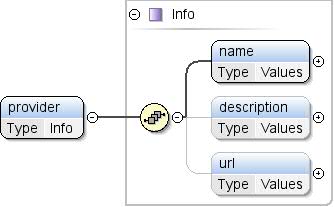 |
|---|
| টাইপ | তথ্য |
|---|
| বৈশিষ্ট্য | |
|---|
| মডেল | নাম , বিবরণ{0,1} , url{0,1} |
|---|
| শিশুরা | বর্ণনা , নাম , url |
|---|
| দৃষ্টান্ত | <provider>
<name>{1,1}</name>
<description>{0,1}</description>
<url>{0,1}</url>
</provider> |
|---|
| উৎস | <xs:element name="provider" type="Info">
<xs:annotation>
<xs:documentation>General information about the dataset provider.</xs:documentation>
</xs:annotation>
</xs:element> |
|---|
উপাদান: dspl / বৈশিষ্ট্য
| নামস্থান | http://schemas.google.com/dspl/2010 |
|---|
| টীকা | ডেটাসেটের সাথে যুক্ত অ্যাট্রিবিউট। |
|---|
| ডায়াগ্রাম | 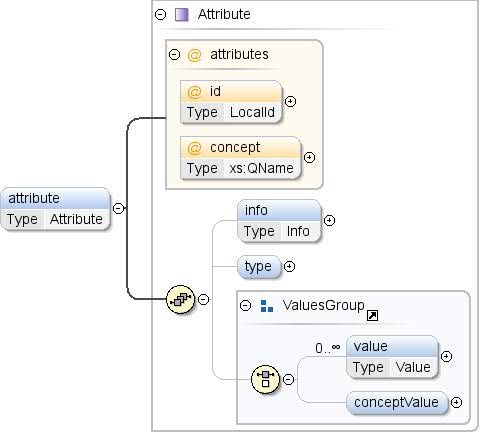 |
|---|
| টাইপ | বৈশিষ্ট্য |
|---|
| বৈশিষ্ট্য | | বিষয়বস্তু: | জটিল |
|---|
| সামান্য ঘটনা: | 0 |
|---|
| সর্বাধিক ঘটনা: | সীমাহীন |
|---|
|
|---|
| মডেল | তথ্য{0,1} , টাইপ{0,1} , ( মান* | ধারণামূল্য{0,1} ) |
|---|
| শিশুরা | ধারণামূল্য , তথ্য , প্রকার , মান |
|---|
| দৃষ্টান্ত | <attribute concept="" id="">
<info>{0,1}</info>
<type format="" ref="">{0,1}</type>
</attribute> |
|---|
| গুণাবলী | | QName | টাইপ | স্থির | ডিফল্ট | ব্যবহার করুন | টীকা |
|---|
| ধারণা | xs:QName | | | ঐচ্ছিক | বৈশিষ্ট্যের মানগুলির সাথে সামঞ্জস্যপূর্ণ একটি ধারণার একটি রেফারেন্স৷ যদি অ্যাট্রিবিউটটি একটি টাইপ নির্দিষ্ট করে, তাহলে টাইপটি অবশ্যই উল্লেখিত ধারণার ধরনের সাথে মিলবে। একটি বাহ্যিক ধারণার একটি রেফারেন্স অবশ্যই "উপসর্গ:other_concept_id" ফর্মের হতে হবে, যেখানে "উপসর্গ" বহিরাগত ডেটাসেটের নামস্থানের জন্য ব্যবহৃত উপসর্গ (এক্সএমএল নেমস্পেস দেখুন)। |
|---|
| আইডি | স্থানীয় আইডি | | | ঐচ্ছিক | ধারণা বৈশিষ্ট্যের আইডি। এই শনাক্তকারীকে অবশ্যই ধারণার মধ্যে অনন্য হতে হবে (গুণাবলী এবং বৈশিষ্ট্য জুড়ে)। ধারণা বৈশিষ্ট্য নির্দিষ্ট করা থাকলে আইডিটি বাদ দেওয়া হতে পারে। সেক্ষেত্রে, একটি আইডি হল রেফারেন্সকৃত ধারণার স্থানীয় নামের মান দিয়ে তৈরি করা অন্তর্নিহিততা। উদাহরণস্বরূপ <attribute concept="unit:currency"/> হল <attribute id="currency" concept="unit:currency"/> এর সমতুল্য |
|---|
|
|---|
| উৎস | <xs:element name="attribute" type="Attribute" minOccurs="0" maxOccurs="unbounded">
<xs:annotation>
<xs:documentation>Attribute associated with the dataset.</xs:documentation>
</xs:annotation>
</xs:element> |
|---|
| নামস্থান | http://schemas.google.com/dspl/2010 |
|---|
| টীকা | ডেটাসেটের বিষয়বস্তু সংগঠিত করতে ব্যবহৃত বিষয়গুলির একটি অনুক্রম। যে ক্রমে বিষয়গুলি দেওয়া হয়েছে তা অর্থপূর্ণ এবং এই বিষয়গুলি প্রদর্শন করে এমন ভিজ্যুয়ালাইজেশনের দ্বারা সম্মান করা উচিত৷ |
|---|
| ডায়াগ্রাম |  |
|---|
| বৈশিষ্ট্য | | বিষয়বস্তু: | জটিল |
|---|
| সামান্য ঘটনা: | 0 |
|---|
|
|---|
| মডেল | বিষয়+ |
|---|
| শিশুরা | বিষয় |
|---|
| দৃষ্টান্ত | <topics>
<topic id="" parentTopic="">{1,unbounded}</topic>
</topics> |
|---|
| উৎস | <xs:element name="topics" minOccurs="0">
<xs:annotation>
<xs:documentation>A hierarchy of topics used to organize the contents of
the dataset. The order in which topics are given is
meaningful and should be respected by visualizations
that displays these topics.</xs:documentation>
</xs:annotation>
<xs:complexType>
<xs:sequence>
<xs:element name="topic" type="Topic" maxOccurs="unbounded"/>
</xs:sequence>
</xs:complexType>
</xs:element> |
|---|
| নামস্থান | http://schemas.google.com/dspl/2010 |
|---|
| ডায়াগ্রাম | 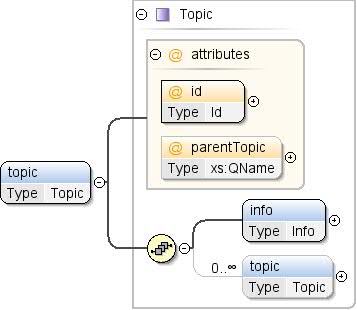 |
|---|
| টাইপ | বিষয় |
|---|
| বৈশিষ্ট্য | | বিষয়বস্তু: | জটিল |
|---|
| সর্বাধিক ঘটনা: | সীমাহীন |
|---|
|
|---|
| মডেল | তথ্য , বিষয়* |
|---|
| শিশুরা | তথ্য , বিষয় |
|---|
| দৃষ্টান্ত | <topic id="" parentTopic="">
<info>{1,1}</info>
<topic id="" parentTopic="">{0,unbounded}</topic>
</topic> |
|---|
| গুণাবলী | | QName | টাইপ | স্থির | ডিফল্ট | ব্যবহার করুন | টীকা |
|---|
| আইডি | আইডি | | | প্রয়োজনীয় | ডেটাসেটে বিষয়ের অনন্য শনাক্তকারী। |
|---|
| অভিভাবক বিষয় | xs:QName | | | ঐচ্ছিক | এই বিষয়ের মূল বিষয়ের আইডি, যদি এটি একটি থাকে। অন্যান্য বিষয়ের ভিতরে ইনলাইন করা বিষয়গুলির জন্য parentTopic নির্দিষ্ট করা যাবে না। |
|---|
|
|---|
| উৎস | <xs:element name="topic" type="Topic" maxOccurs="unbounded"/> |
|---|
উপাদান: dspl / ধারণা
| নামস্থান | http://schemas.google.com/dspl/2010 |
|---|
| টীকা | এই ডেটাসেটে সংজ্ঞায়িত ধারণাগুলির একটি তালিকা। |
|---|
| ডায়াগ্রাম |  |
|---|
| বৈশিষ্ট্য | | বিষয়বস্তু: | জটিল |
|---|
| সামান্য ঘটনা: | 0 |
|---|
|
|---|
| মডেল | ধারণা+ |
|---|
| শিশুরা | ধারণা |
|---|
| দৃষ্টান্ত | <concepts>
<concept extends="" id="">{1,unbounded}</concept>
</concepts> |
|---|
| উৎস | <xs:element name="concepts" minOccurs="0">
<xs:annotation>
<xs:documentation>A list of concepts defined in this dataset.</xs:documentation>
</xs:annotation>
<xs:complexType>
<xs:sequence>
<xs:element name="concept" type="Concept" maxOccurs="unbounded"/>
</xs:sequence>
</xs:complexType>
</xs:element> |
|---|
| নামস্থান | http://schemas.google.com/dspl/2010 |
|---|
| ডায়াগ্রাম | 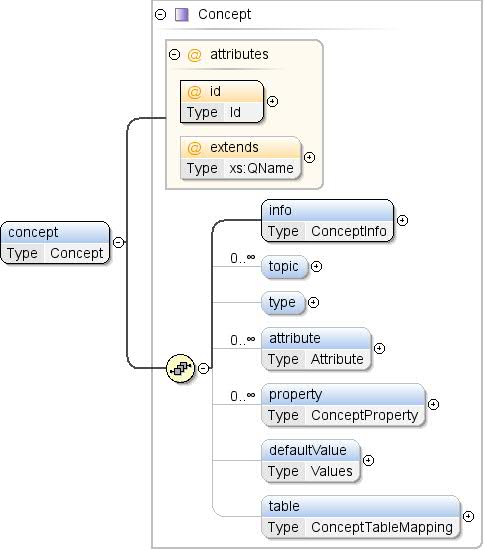 |
|---|
| টাইপ | ধারণা |
|---|
| বৈশিষ্ট্য | | বিষয়বস্তু: | জটিল |
|---|
| সর্বাধিক ঘটনা: | সীমাহীন |
|---|
|
|---|
| মডেল | তথ্য , বিষয়* , প্রকার{0,1} , বৈশিষ্ট্য* , সম্পত্তি* , ডিফল্ট মান{0,1} , টেবিল{0,1} |
|---|
| শিশুরা | বৈশিষ্ট্য , ডিফল্ট মান , তথ্য , সম্পত্তি , টেবিল , বিষয় , প্রকার |
|---|
| দৃষ্টান্ত | <concept extends="" id="">
<info>{1,1}</info>
<topic ref="">{0,unbounded}</topic>
<type ref="">{0,1}</type>
<attribute concept="" id="">{0,unbounded}</attribute>
<property concept="" id="" isMapping="false" isParent="false">{0,unbounded}</property>
<defaultValue>{0,1}</defaultValue>
<table ref="">{0,1}</table>
</concept> |
|---|
| গুণাবলী | | QName | টাইপ | স্থির | ডিফল্ট | ব্যবহার করুন | টীকা |
|---|
| প্রসারিত | xs:QName | | | ঐচ্ছিক | একটি ধারণার অনন্য শনাক্তকারী যা এই ধারণাটি প্রসারিত করে। উল্লেখিত ধারণা একই ডেটাসেটে বা বাহ্যিকভাবে সংজ্ঞায়িত করা যেতে পারে, অর্থাৎ, অন্য ডেটাসেটে। একটি বাহ্যিক ধারণার একটি রেফারেন্স অবশ্যই "উপসর্গ:other_concept_id" ফর্মের হতে হবে, যেখানে "উপসর্গ" বহিরাগত ডেটাসেটের নামস্থানের জন্য ব্যবহৃত উপসর্গ (এক্সএমএল নেমস্পেস দেখুন)। |
|---|
| আইডি | আইডি | | | প্রয়োজনীয় | ধারণাটির অনন্য শনাক্তকারী, যা ডেটাসেটের মধ্যে বিশ্বব্যাপী অনন্য হতে হবে। |
|---|
|
|---|
| উৎস | <xs:element name="concept" type="Concept" maxOccurs="unbounded"/> |
|---|
উপাদান: ডিএসপিএল / স্লাইস
| নামস্থান | http://schemas.google.com/dspl/2010 |
|---|
| টীকা | এই ডেটাসেটে সংজ্ঞায়িত স্লাইসগুলির একটি তালিকা৷ |
|---|
| ডায়াগ্রাম |  |
|---|
| বৈশিষ্ট্য | | বিষয়বস্তু: | জটিল |
|---|
| সামান্য ঘটনা: | 0 |
|---|
|
|---|
| মডেল | স্লাইস+ |
|---|
| শিশুরা | টুকরা |
|---|
| দৃষ্টান্ত | <slices>
<slice id="">{1,unbounded}</slice>
</slices> |
|---|
| উৎস | <xs:element name="slices" minOccurs="0">
<xs:annotation>
<xs:documentation>A list of slices defined in this dataset.</xs:documentation>
</xs:annotation>
<xs:complexType>
<xs:sequence>
<xs:element name="slice" type="Slice" maxOccurs="unbounded"/>
</xs:sequence>
</xs:complexType>
</xs:element> |
|---|
| নামস্থান | http://schemas.google.com/dspl/2010 |
|---|
| ডায়াগ্রাম | 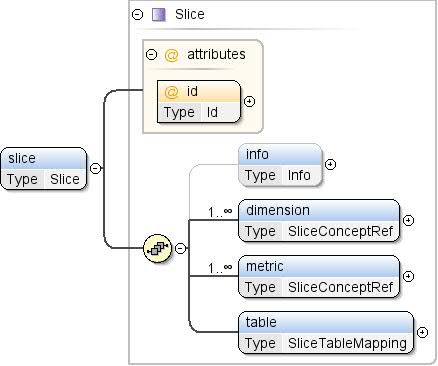 |
|---|
| টাইপ | স্লাইস |
|---|
| বৈশিষ্ট্য | | বিষয়বস্তু: | জটিল |
|---|
| সর্বাধিক ঘটনা: | সীমাহীন |
|---|
|
|---|
| মডেল | তথ্য{0,1} , মাত্রা+ , মেট্রিক+ , টেবিল |
|---|
| শিশুরা | মাত্রা , তথ্য , মেট্রিক , টেবিল |
|---|
| দৃষ্টান্ত | <slice id="">
<info>{0,1}</info>
<dimension concept="">{1,unbounded}</dimension>
<metric concept="">{1,unbounded}</metric>
<table ref="">{1,1}</table>
</slice> |
|---|
| গুণাবলী | | QName | টাইপ | স্থির | ডিফল্ট | ব্যবহার করুন | টীকা |
|---|
| আইডি | আইডি | | | প্রয়োজনীয় | স্লাইসের অনন্য শনাক্তকারী। |
|---|
|
|---|
| উৎস | <xs:element name="slice" type="Slice" maxOccurs="unbounded"/> |
|---|
| নামস্থান | http://schemas.google.com/dspl/2010 |
|---|
| টীকা | এই ডেটাসেটে সংজ্ঞায়িত টেবিলের একটি তালিকা। |
|---|
| ডায়াগ্রাম |  |
|---|
| বৈশিষ্ট্য | | বিষয়বস্তু: | জটিল |
|---|
| সামান্য ঘটনা: | 0 |
|---|
|
|---|
| মডেল | টেবিল+ |
|---|
| শিশুরা | টেবিল |
|---|
| দৃষ্টান্ত | <tables>
<table id="">{1,unbounded}</table>
</tables> |
|---|
| উৎস | <xs:element name="tables" minOccurs="0">
<xs:annotation>
<xs:documentation>A list of tables defined in this dataset.</xs:documentation>
</xs:annotation>
<xs:complexType>
<xs:sequence>
<xs:element name="table" type="Table" maxOccurs="unbounded"/>
</xs:sequence>
</xs:complexType>
</xs:element> |
|---|
| নামস্থান | http://schemas.google.com/dspl/2010 |
|---|
| ডায়াগ্রাম |  |
|---|
| টাইপ | টেবিল |
|---|
| বৈশিষ্ট্য | | বিষয়বস্তু: | জটিল |
|---|
| সর্বাধিক ঘটনা: | সীমাহীন |
|---|
|
|---|
| মডেল | তথ্য{0,1} , কলাম+ , ডেটা{0,1} |
|---|
| শিশুরা | কলাম , ডেটা , তথ্য |
|---|
| দৃষ্টান্ত | <table id="">
<info>{0,1}</info>
<column format="" id="" type="">{1,unbounded}</column>
<data>{0,1}</data>
</table> |
|---|
| গুণাবলী | | QName | টাইপ | স্থির | ডিফল্ট | ব্যবহার করুন | টীকা |
|---|
| আইডি | আইডি | | | প্রয়োজনীয় | ডেটাসেটে টেবিলের অনন্য শনাক্তকারী। |
|---|
|
|---|
| উৎস | <xs:element name="table" type="Table" maxOccurs="unbounded"/> |
|---|
বৈশিষ্ট্য: dspl / import /@namespace
| নামস্থান | কোনো নামস্থান নেই |
|---|
| টীকা | আমদানি করা ডেটাসেটের নামস্থান, একটি URI হিসাবে নির্দিষ্ট করা হয়েছে৷ এর বিষয়বস্তু উল্লেখ করার আগে একটি উপসর্গ অবশ্যই এই নামস্থানের সাথে যুক্ত থাকতে হবে। XML-এ নেমস্পেস এবং উপসর্গের ব্যবহার সম্পর্কে আরও তথ্যের জন্য [এক্সএমএল নেমস্পেস] দেখুন। |
|---|
| বৈশিষ্ট্য | | ব্যবহার করুন: | প্রয়োজনীয় |
|---|
|
|---|
| দ্বারা ব্যবহৃত | |
|---|
| উৎস | <xs:attribute name="namespace" use="required">
<xs:annotation>
<xs:documentation>The namespace of the imported dataset, specified as
a URI. A prefix must be associated with this
namespace before its contents can be referenced. See
[XML Namespaces] for more information about the use
of namespaces and prefixes in XML.</xs:documentation>
</xs:annotation>
</xs:attribute> |
|---|
বৈশিষ্ট্য: dspl / import /@location
| নামস্থান | কোনো নামস্থান নেই |
|---|
| টীকা | একটি ঐচ্ছিক অবস্থান যেখানে আমদানি করা ডেটাসেটের সংজ্ঞা পাওয়া যেতে পারে, একটি URL হিসাবে নির্দিষ্ট করা হয়েছে৷ যদি অবস্থানটি বাদ দেওয়া হয়, এই DSPL ডেটাসেট প্রক্রিয়াকরণকারী সিস্টেমটি ইতিমধ্যেই আমদানি করা ডেটাসেটটি জানতে হবে৷ ইমপ্লিমেন্টেশন নোট: Google ডেটাসেট ইম্পোর্টার লোকেশন অ্যাট্রিবিউট উপেক্ষা করে। যেকোনো আমদানি করা ডেটাসেট অবশ্যই Google আমদানিকারককে আগে থেকেই জানতে হবে। |
|---|
| বৈশিষ্ট্য | |
|---|
| দ্বারা ব্যবহৃত | |
|---|
| উৎস | <xs:attribute name="location" use="optional">
<xs:annotation>
<xs:documentation>An optional location where the definition of the
imported dataset can be found, specified as a
URL. If the location is omitted, the system
processing this DSPL dataset must already know the
imported dataset.
Implementation note: The Google dataset importer
ignores the location attribute. Any imported dataset
must be known by the Google importer beforehand.</xs:documentation>
</xs:annotation>
</xs:attribute> |
|---|
বৈশিষ্ট্য: dspl / @targetNamespace
| নামস্থান | কোনো নামস্থান নেই |
|---|
| টীকা | প্রতিটি ডেটাসেট একটি টার্গেট নেমস্পেস প্রদান করতে পারে। টার্গেট নেমস্পেস হল একটি URI যা ডেটাসেটটিকে অনন্যভাবে সনাক্ত করে। XML-এ নেমস্পেসের ব্যবহার সম্পর্কে আরও তথ্যের জন্য, দেখুন: http://www.w3.org/TR/REC-xml-names/ যদি কোন টার্গেটনেমস্পেস প্রদান করা না হয়, তাহলে ডেটাসেট আমদানি করা হলে একটি নামস্থান তৈরি করা হবে। |
|---|
| টাইপ | xs:anyURI |
|---|
| বৈশিষ্ট্য | |
|---|
| দ্বারা ব্যবহৃত | |
|---|
| উৎস | <xs:attribute name="targetNamespace" type="xs:anyURI" use="optional">
<xs:annotation>
<xs:documentation>Each dataset may provide a target namespace. The
target namespace is a URI that uniquely identifies the
dataset. For more information about the use of namespaces in XML,
see:
http://www.w3.org/TR/REC-xml-names/
If no targetNamespace is provided, then a namespace will be
generated when the dataset is imported.</xs:documentation>
</xs:annotation>
</xs:attribute> |
|---|
অক্সিজেন এক্সএমএল এডিটর ব্যবহার করে তৈরি করা হয়েছে।
অন্য কিছু উল্লেখ না করা থাকলে, এই পৃষ্ঠার কন্টেন্ট Creative Commons Attribution 4.0 License-এর অধীনে এবং কোডের নমুনাগুলি Apache 2.0 License-এর অধীনে লাইসেন্স প্রাপ্ত। আরও জানতে, Google Developers সাইট নীতি দেখুন। Java হল Oracle এবং/অথবা তার অ্যাফিলিয়েট সংস্থার রেজিস্টার্ড ট্রেডমার্ক।
2025-07-25 UTC-তে শেষবার আপডেট করা হয়েছে।
[null,null,["2025-07-25 UTC-তে শেষবার আপডেট করা হয়েছে।"],[],["The DSPL XML schema defines a dataset's structure using key components: `tables`, `concepts`, `slices`, and `topics`. The root `dspl` element encapsulates the dataset, utilizing `import` to reference externals, `info` and `provider` for metadata, `attribute` for dataset attributes, and `topics` to hierarchically organize the concepts. `concepts`, `slices`, `tables` are for concept definition, slice definition, and data table, respectively. Each element like `import`, `info`, `provider`, `attribute`, `topic`, `concept`, `slice`, `table` uses specific attributes and child elements for configuration. Each element has a specific cardinality that is defined in the document.\n"]]













